Your cart is currently empty!
Bridging Time: The Story and Spirit of the Brooklyn Bridge
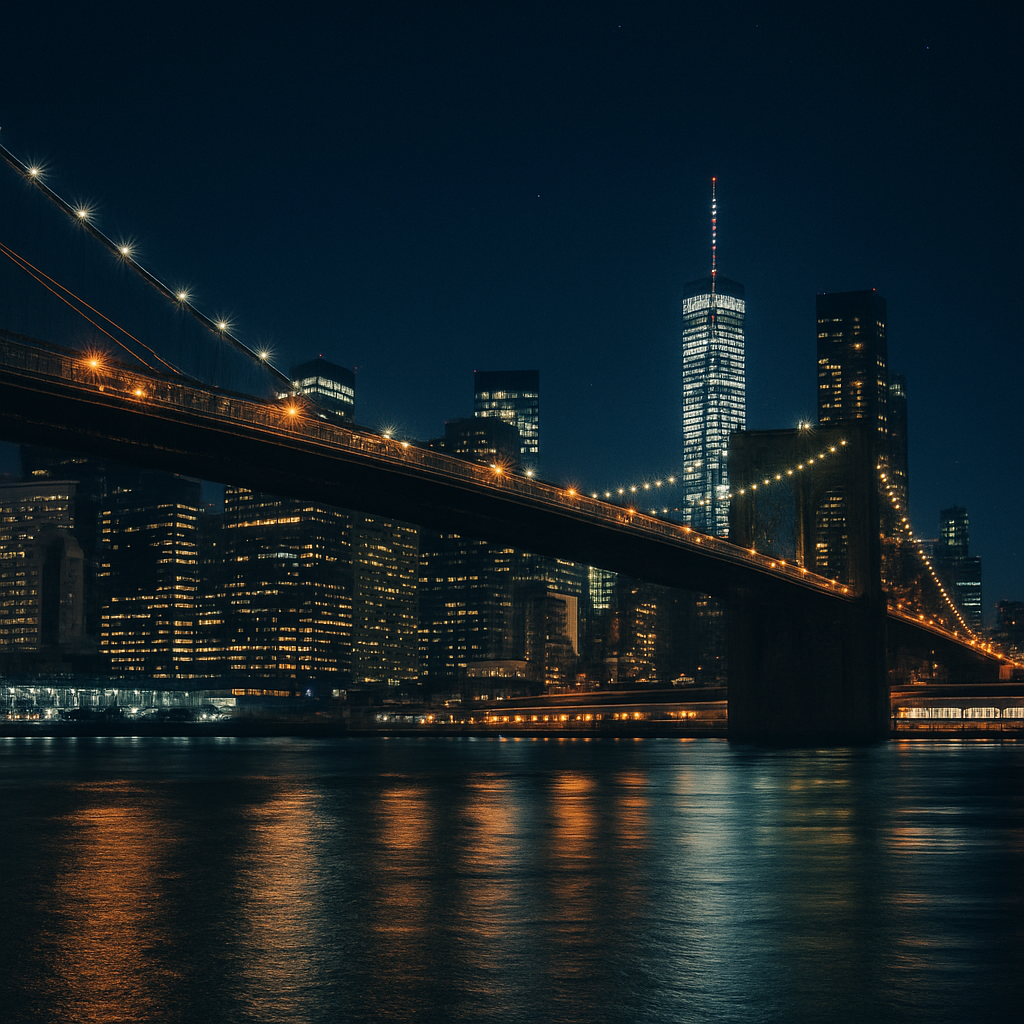
The Brooklyn Bridge is more than a structure—it’s a symbol of dreams made real in steel and stone. Spanning the East River between Manhattan and Brooklyn, it has stood for nearly a century and a half as one of the most recognizable landmarks in the world. It embodies the ambition of a growing city, the courage of the people who built it, and the timeless beauty of great design. To walk across it is to walk through history—a story of innovation, perseverance, and connection.
From the moment it opened in 1883, the Brooklyn Bridge captured hearts and imaginations. It wasn’t just the longest suspension bridge of its time—it was proof that human ingenuity could overcome almost any obstacle. Today, millions of people cross it each year, taking in sweeping views of the New York City skyline, the East River below, and the enduring sense that this bridge isn’t just built between two boroughs—it’s built between the past and the future.

The Birth of an Idea
In the mid-1800s, Brooklyn and Manhattan were two separate cities, each buzzing with growth. Every day, ferries shuttled people and goods across the East River, but the currents were strong, the weather unpredictable, and the need for a more reliable connection was clear. That’s when a visionary engineer named John Augustus Roebling proposed an idea that seemed almost impossible: a bridge that would span the East River without obstructing its busy shipping lanes.
At that time, suspension bridges were still a new and risky form of engineering. But Roebling had already built smaller ones successfully and was convinced that with the right materials and design, a bridge linking Manhattan and Brooklyn could be built—and could stand the test of time.
His idea wasn’t just about transportation; it was about unity. The bridge would physically and symbolically bring the two cities together, reflecting a nation that was growing and redefining itself after the turmoil of the Civil War.
Roebling’s vision was bold. He wanted a bridge longer than any ever attempted, one that could withstand powerful tides, winds, and the weight of thousands of people and vehicles. It would require materials stronger than iron, new construction techniques, and years of dedication. It would also demand faith—from financiers, politicians, workers, and the public. In the end, the project would take 14 years, claim dozens of lives, and change the course of engineering forever.
Building the Impossible
The construction of the Brooklyn Bridge began in 1870, but it quickly became one of the most challenging engineering feats of the 19th century. The first step was to lay the foundations deep beneath the East River using enormous wooden boxes called caissons. These watertight chambers were sunk into the riverbed, and workers—known as “sandhogs”—dug out sediment from within them under high air pressure. It was dangerous work. Many workers suffered from what was then called “caisson disease,” now known as the bends, a painful and sometimes fatal condition caused by rapid decompression.
Tragedy struck early when John Roebling himself was injured in an accident during the initial stages of construction. He developed an infection and died soon after. The leadership of the project then passed to his son, Washington Roebling, who had worked alongside him and was equally brilliant.
Tragedy struck early when John Roebling himself was injured in an accident during the initial stages of construction. He developed an infection and died soon after. The leadership of the project then passed to his son, Washington Roebling, who had worked alongside him and was equally brilliant. But as fate would have it, Washington too became seriously ill from caisson disease. Confined to his home, he was left unable to oversee construction in person.
This could have been the end of the dream. Instead, something extraordinary happened. Washington’s wife, Emily Warren Roebling, stepped in. With remarkable intelligence and determination, she studied engineering, mathematics, and materials science so she could act as her husband’s eyes and ears on the project. Every day, she carried messages and instructions to the workers, monitored progress, and handled correspondence with engineers and city officials. Without her, the bridge might never have been completed. Her role became a defining example of quiet heroism—an often-overlooked contribution to one of the greatest engineering achievements in history.
Strength and Grace in Stone and Steel
The Brooklyn Bridge wasn’t just a technical marvel; it was also a masterpiece of design. Rising from the river, its twin towers were built from granite, limestone, and cement, reaching nearly 280 feet into the sky. Their Gothic-style pointed arches gave the bridge its signature look—majestic, timeless, and instantly recognizable. The towers were not only structural pillars but also works of art, symbolizing strength and stability.
From these towers, four enormous cables—each made of more than 5,000 steel wires—were strung across the river. At the time, steel was a new material for bridge construction, stronger and more flexible than iron, and its use was revolutionary. These main cables supported a network of smaller vertical wires that held up the deck, creating a web-like pattern that still fascinates photographers and visitors today.
The result was a bridge that combined beauty and practicality like no other. The roadway was designed to carry carriages, trolleys, trains, and pedestrians, with an elevated promenade running down the center. That walkway, still open today, remains one of the most beloved features of the bridge. It gives walkers and cyclists an unobstructed view of the Manhattan skyline, the Statue of Liberty in the distance, and the powerful flow of the East River beneath their feet.
When it was completed in 1883, the Brooklyn Bridge stretched 1,595 feet between towers—making it the longest suspension bridge in the world. Its construction had cost more than $15 million and taken the lives of more than twenty men. But it stood as a triumph of engineering and an enduring symbol of what human beings can achieve when they dare to dream beyond the limits of their time.
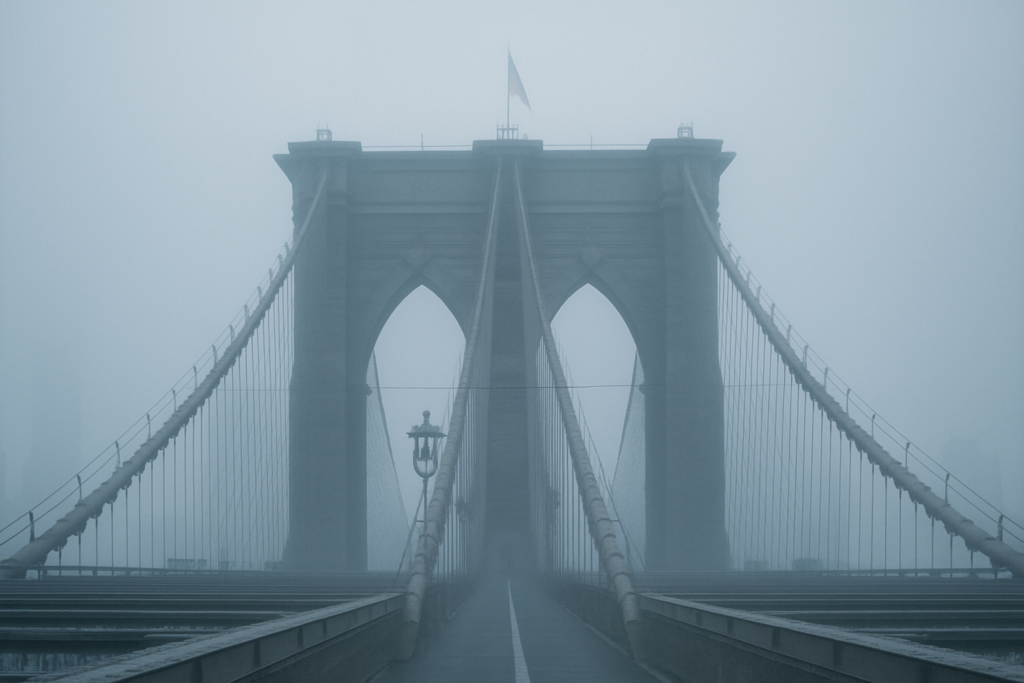
The Grand Opening
On May 24, 1883, tens of thousands of people gathered to witness the opening of the Brooklyn Bridge. Cannon fire echoed, bands played, flags waved, and fireworks lit up the night sky. The President of the United States, Chester A. Arthur, crossed the bridge alongside the mayor of New York. Emily Roebling herself made the first official trip across, carrying a rooster as a symbol of victory. It was a moment of celebration and awe—the kind that defines an era.
That first day, over 150,000 people crossed the bridge on foot or by carriage, marveling at the views and the sheer scale of the structure. Many had doubted it would ever be completed, but there it stood—strong, silent, magnificent. The Brooklyn Bridge instantly became a source of pride for New Yorkers and an inspiration to the world.
Of course, not everyone trusted it at first. A week after opening, a rumor spread that the bridge was collapsing, causing a stampede that led to several deaths. To restore public confidence, a famous showman led a parade of 21 elephants across the bridge—a spectacle that convinced everyone it was truly safe. From then on, the Brooklyn Bridge wasn’t just a crossing; it was a legend.
The Bridge That Changed a City
The Brooklyn Bridge didn’t just connect two boroughs—it transformed them. Before the bridge, Brooklyn was its own city, independent from Manhattan. But the new link made it easier for people to travel, trade, and work across the river. It helped spark Brooklyn’s growth and laid the foundation for the two cities to merge into one New York City in 1898. It was both a physical and symbolic unification.
As the decades passed, the bridge adapted to new technologies and ways of life. Horse-drawn carriages gave way to automobiles. Electric trolleys once ran along its lanes before being replaced by cars and trucks. For a time, trains even crossed the bridge. Today, six lanes carry vehicles between Manhattan and Brooklyn, while the upper promenade remains reserved for pedestrians and cyclists. Despite constant use, the bridge continues to serve its city with remarkable endurance.
The bridge’s design also influenced countless others around the world. It proved that suspension bridges could be both strong and elegant, paving the way for giants like the Golden Gate Bridge and the Verrazzano-Narrows Bridge. Its combination of engineering precision and architectural grace set a new standard that many would follow but few could equal.
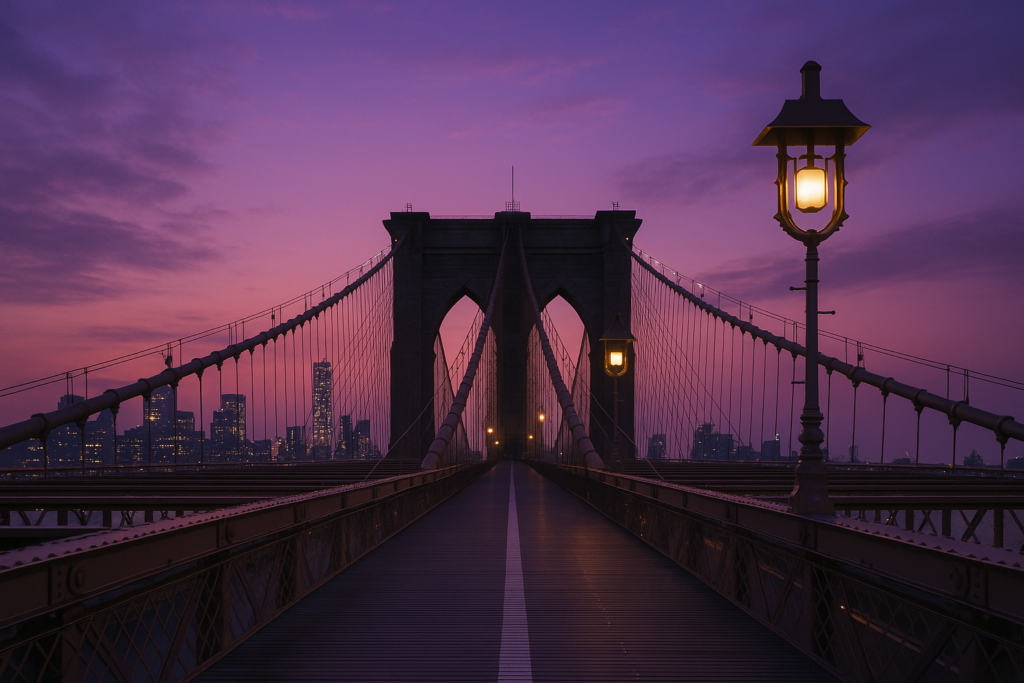
A Symbol in Stone and Imagination
Over time, the Brooklyn Bridge has become more than infrastructure—it’s a cultural icon. It appears in paintings, poems, films, and songs. Artists like Joseph Stella captured its sweeping geometry; writers like Walt Whitman and Hart Crane saw it as a metaphor for hope and transcendence. To photographers, it’s a dream subject: the perfect blend of symmetry, perspective, and light.
For New Yorkers, it’s something deeper—a daily reminder of resilience. Through wars, depressions, and blackouts, the bridge has endured. It’s watched the city grow from horse carts to skyscrapers, from gas lamps to neon lights, from the Industrial Age to the Digital one. And yet, when you stand in the middle of it and look out at the skyline, it feels timeless. The cables hum in the wind. The stone towers glow in the sunrise or shimmer at sunset. The noise of traffic below fades, and for a moment, you feel suspended between the old world and the new.
The phrase “selling the Brooklyn Bridge” even became part of American slang, referring to an impossible con or an unbelievable claim. That, too, is part of its mystique: the bridge has always represented big dreams and bigger promises.
The Bridge Today
Today, the Brooklyn Bridge carries over a hundred thousand vehicles each day, along with thousands of pedestrians and cyclists. Despite its age, it remains a vital artery in New York’s transportation network. Regular maintenance keeps it safe and strong, though ongoing restoration projects are often needed to combat weathering and the wear of time. The city continues to invest in upgrades—improving lighting, resurfacing the pedestrian walkway, reinforcing cables, and enhancing safety.
Beneath the bridge, new life has emerged as well. Once an industrial zone, the area now includes parks, cafes, and community spaces. The views from Brooklyn Bridge Park—especially at sunset—offer some of the best perspectives of Manhattan you’ll find anywhere in the city. The bridge itself has become a favorite location for movies, weddings, and photographs, drawing millions of tourists from around the world.
In recent years, the city has also made efforts to improve the pedestrian and cycling experience, separating lanes to reduce congestion and ensuring the bridge remains accessible to everyone. Crossing the Brooklyn Bridge on foot has become one of New York’s most beloved experiences—a journey through history and beauty rolled into one.
Walking the Bridge: An Experience Like No Other
If you visit New York, walking the Brooklyn Bridge is an absolute must. The best times are early morning, when the city is just waking up and the air is cool, or during sunset, when the sky turns gold and pink over the skyline. From Brooklyn, you’ll see Manhattan rise in front of you like a promise. From Manhattan, you’ll watch the towers of Brooklyn grow closer, framed by the evening light.
As you walk, you’ll notice the rhythm of the cables, the echoes of footsteps on wooden planks, and the distant hum of the city. Street performers, artists, and vendors line parts of the walkway, adding color and sound to the experience. You can pause at the center to take in panoramic views of the Statue of Liberty, the Empire State Building, and the shimmering river below.
Walking the bridge is free, open 24 hours a day, and always unforgettable. It’s not just sightseeing—it’s participation in a living piece of history. Every step is a reminder of those who dreamed it, built it, and preserved it for the generations who follow.
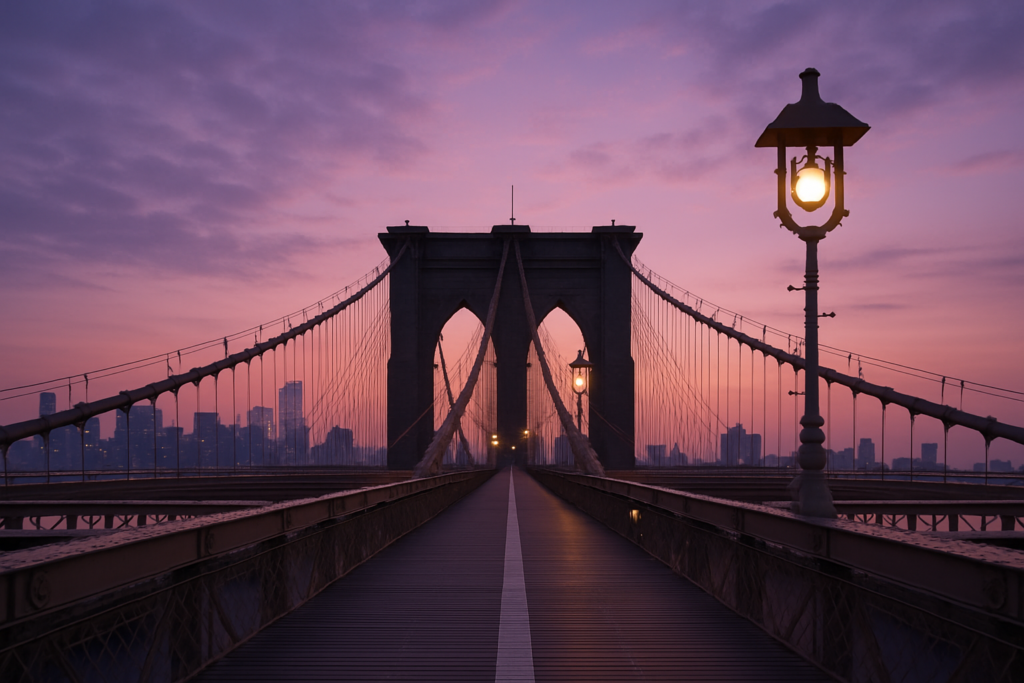
Preservation and the Future
Maintaining a 19th-century bridge in a 21st-century city is no small task. The Brooklyn Bridge faces constant stress from traffic, weather, and time. Engineers regularly inspect the structure, reinforcing where necessary and replacing worn materials while preserving its original appearance. Because of its landmark status, every modification must balance preservation with modernization.
Efforts are also underway to make the surrounding areas more vibrant. The space beneath the Manhattan side has been turned into a public area known as “The Arches,” featuring courts, seating, and cultural programming. In Brooklyn, the waterfront has been transformed into a scenic park. These projects not only beautify the area but also reconnect communities with the bridge as both a functional and cultural space.
The bridge has survived countless challenges—storms, accidents, and even ships striking its undercarriage. Yet it endures, stronger than ever, a reminder that great design can transcend generations. Future restoration plans aim to maintain that strength while making the bridge more sustainable and accessible.
The Meaning of the Brooklyn Bridge
More than anything, the Brooklyn Bridge stands for connection. It links boroughs, neighborhoods, and lives. It links art and engineering, history and modernity, dream and reality. It connects not just two shores, but the idea that when people come together with courage and vision, they can build something that lasts forever.
Every cable, every stone, every plank tells a story of persistence. The bridge was built by immigrants, laborers, engineers, and visionaries—by people who believed in progress even when it seemed impossible. It has seen generations come and go, yet it remains one of the world’s most beloved landmarks, a place where humanity’s creative spirit quite literally spans a river.
Walking across it today, you can feel that legacy. You can sense the hands that built it, the minds that designed it, and the millions who have crossed it since. It is both monument and metaphor—anchored in the past, stretching toward the future.
Conclusion
The Brooklyn Bridge is a masterpiece not only of engineering but of imagination. It began as a dream in the mind of one man, was carried forward by his family and thousands of workers, and has become an enduring symbol of what New York—and indeed humanity—can achieve. It represents hope, resilience, and connection.
When you stand on its wooden walkway, surrounded by the hum of the city, it’s easy to see why it has inspired so many for so long. The skyline stretches before you, the water glimmers below, and the bridge itself seems to breathe—a living reminder that beauty and strength can exist side by side.
The Brooklyn Bridge is not just part of New York’s story; it is part of the world’s story. It reminds us that even the most daring dreams can take shape when we build with vision, courage, and heart. And as long as it stands, the bridge will continue to carry not only people across the river but also the timeless human desire to connect—to reach out, to build, and to believe.
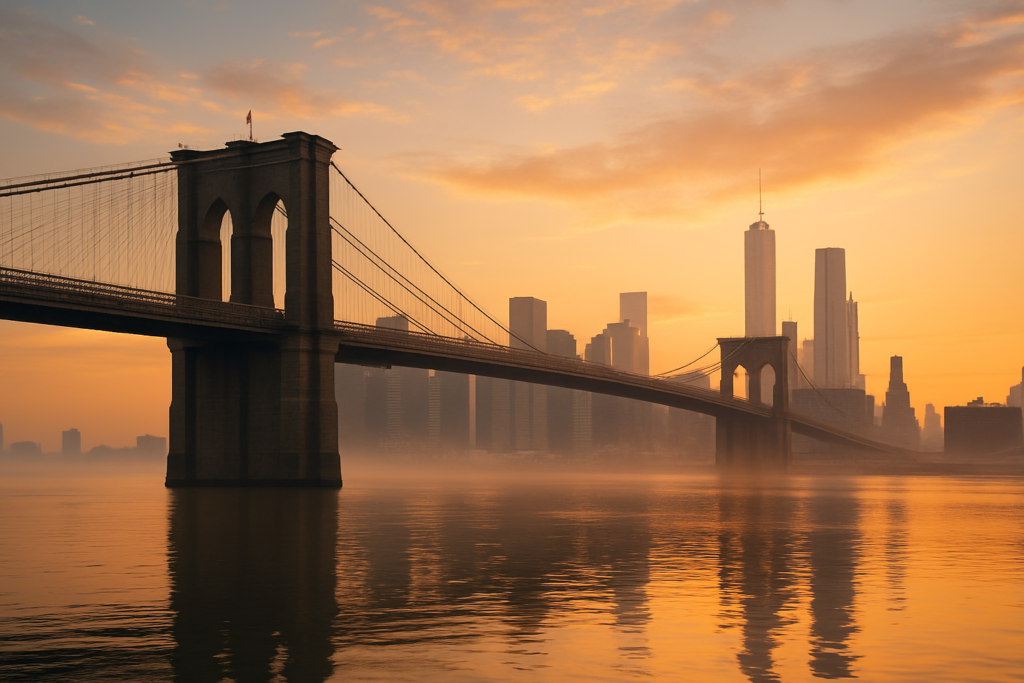

Leave a Reply